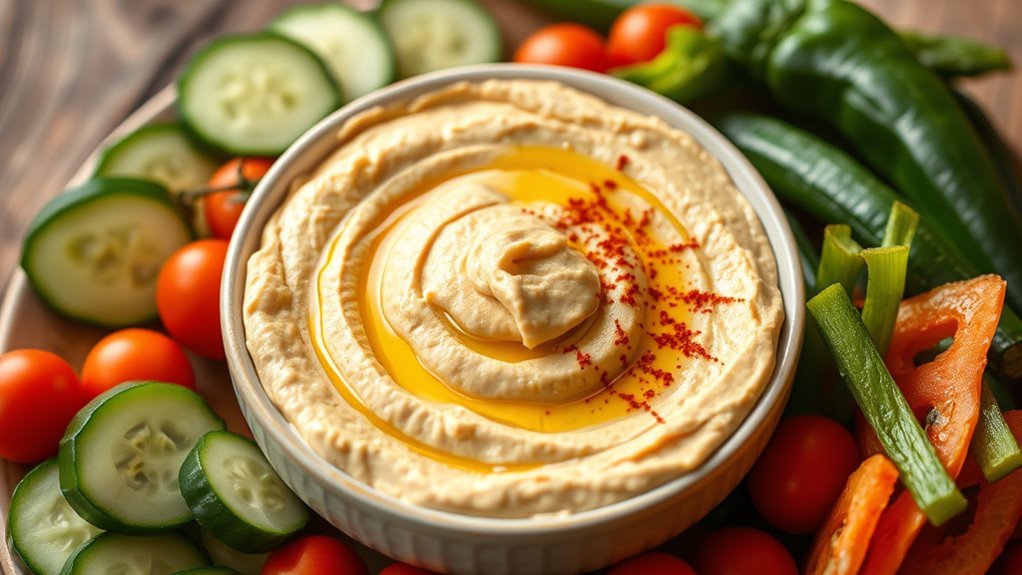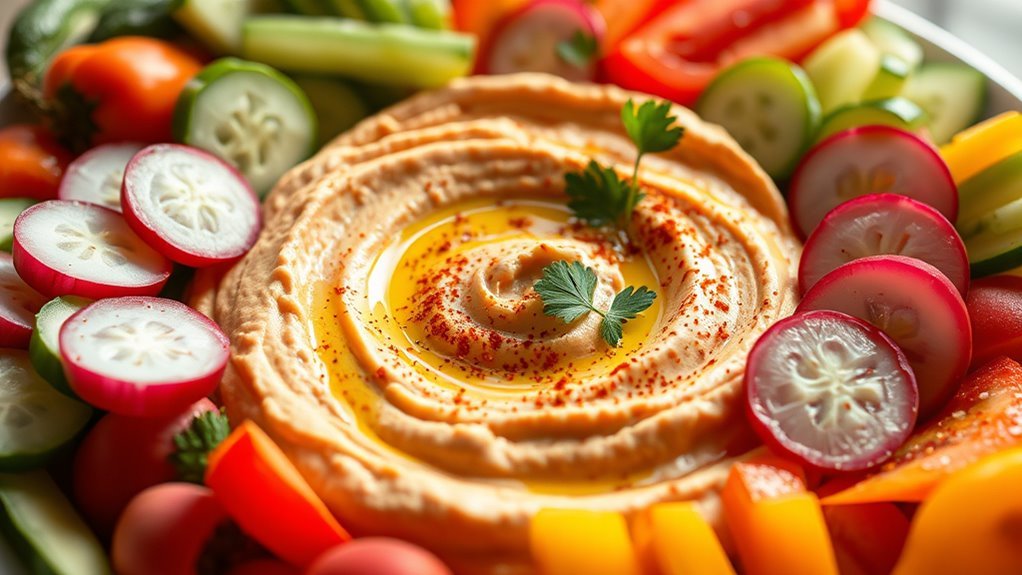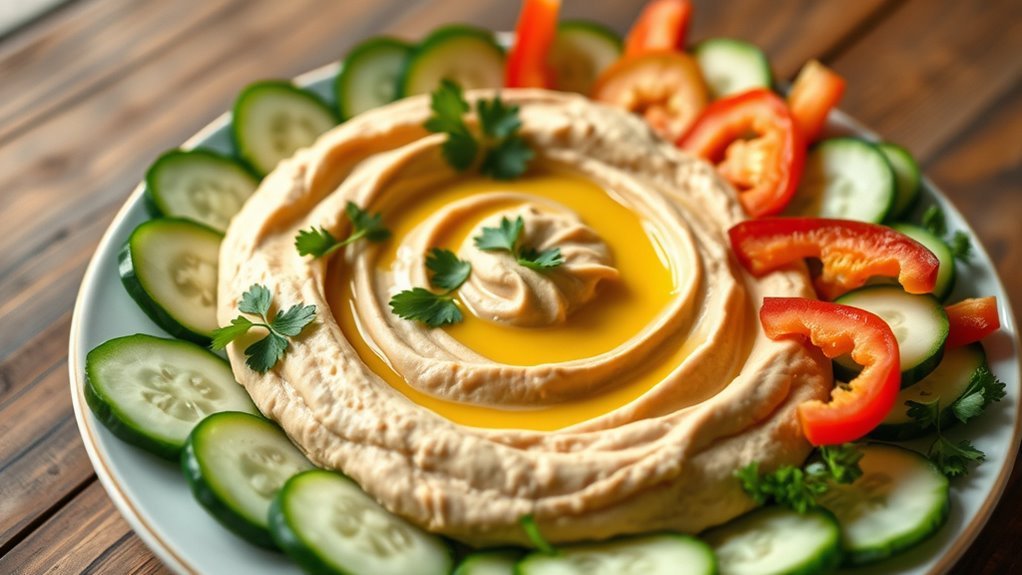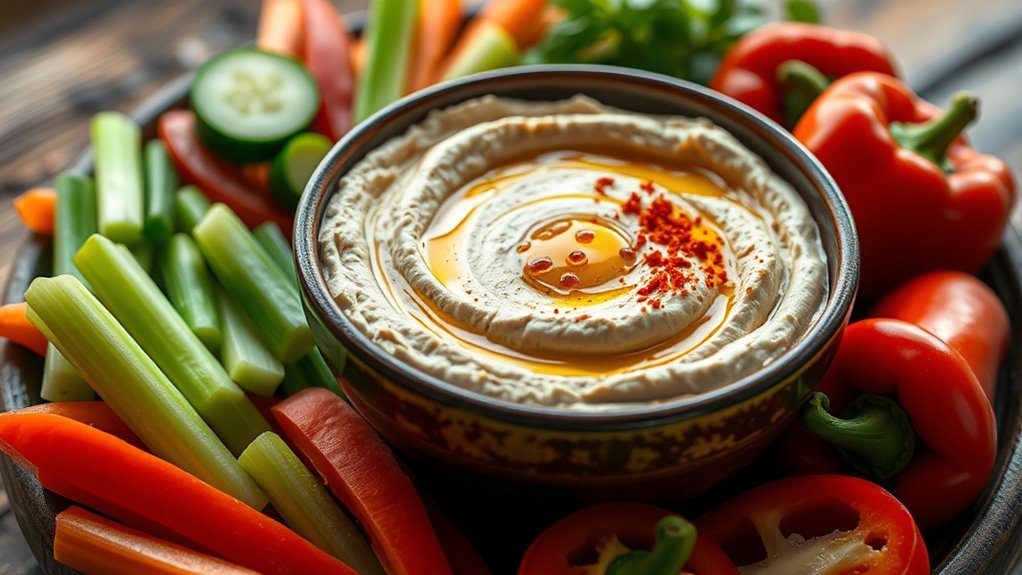Hummus isn’t typically considered keto-friendly due to its carbohydrate content primarily from chickpeas. A two-tablespoon serving averages about 6 grams of carbs, which can add up quickly. While it contains protein and healthy fats, those on a keto diet might struggle to incorporate it without exceeding their carb limits. However, there are low-carb alternatives like avocado or cauliflower hummus. Keep exploring options to enjoy dips without derailing your diet!
Nutritional Breakdown of Hummus

When you look at the nutritional breakdown of hummus, you’ll find that it’s primarily made from chickpeas, tahini, olive oil, lemon juice, and garlic. Each of these hummus ingredients contributes to its unique flavor and health benefits. Chickpeas provide protein and fiber, promoting satiety and digestive health. Tahini adds healthy fats and calcium, while olive oil offers additional monounsaturated fats.
For serving suggestions, you can enjoy hummus with fresh vegetables like carrots and cucumbers, or spread it on whole-grain pita for a satisfying snack. You might also consider using it as a flavorful base for wraps or sandwiches. This versatile dip not only satisfies your taste buds but also aligns with a balanced dietary approach, making it a popular choice for many.
Carbohydrate Content in Hummus

When considering hummus on a keto diet, it’s crucial to look at its carbohydrate content. Typically, a serving contains a significant amount of carbs, which can impact your daily intake. If you’re aiming to stay within keto limits, exploring alternatives and practicing portion control can help you enjoy hummus while managing your carb consumption.
Hummus Carbohydrate Breakdown
Hummus typically contains around 15 grams of carbohydrates per 100 grams, making it important to analyze its carbohydrate breakdown if you’re considering a keto diet. Most of these carbs come from chickpeas, which are the primary ingredient. If you look closer, you’ll find that a portion of these carbs is fiber, which is beneficial for digestion. However, if you’re aiming for a low-carb lifestyle, you might want to explore chickpea alternatives like cauliflower or avocado. These can be used in various hummus recipes to maintain that creamy texture while greatly reducing carbohydrate content. By understanding the carbohydrate breakdown, you can make informed choices that align with your dietary goals, ensuring you have the freedom to enjoy flavorful dishes without compromising your keto plan.
Alternatives for Keto Diet
While traditional hummus may not fit into a strict keto diet, there are several alternatives that can provide a similar taste and texture without the high carbohydrate content. You might consider avocado-based dips, which are creamy and low in carbs. Another option is cauliflower hummus; it’s made from steamed cauliflower blended with tahini, garlic, and lemon juice, making it a great choice for keto snacks. If you want to enjoy your dip with something crunchy, pair it with low carb veggies like cucumber, bell peppers, or celery instead of pita chips. These alternatives allow you to satisfy your cravings while adhering to your keto lifestyle, giving you the freedom to enjoy delicious flavors without the excess carbs.
Portion Control Considerations
Although many people enjoy hummus as a tasty and versatile snack, it’s important to be mindful of portion sizes due to its carbohydrate content. A typical serving of hummus is about two tablespoons, which contains around 4-6 grams of carbs. If you’re following a keto diet, this can add up quickly, especially if you enjoy dipping vegetables or spreading it on low-carb wraps. Practicing mindful eating helps you savor each bite while keeping track of your carb intake. By measuring your portions and being aware of how much hummus you consume, you can still incorporate it into your diet without compromising your keto goals. Balancing enjoyment with awareness is key to maintaining your desired lifestyle.
The Role of Chickpeas in a Keto Diet

When considering chickpeas in a keto diet, it’s important to look at their nutritional profile and carbohydrate content. While they are a good source of protein and fiber, their higher carb count can pose challenges for maintaining ketosis. If you’re looking for alternatives to traditional hummus, there are low-carb options that can help you stick to your dietary goals.
Chickpeas Nutritional Profile
Chickpeas, a staple in many diets, pack a nutritional punch that’s worth examining, especially when evaluating their role in a ketogenic lifestyle. These legumes offer impressive chickpea benefits, including a notable protein content that can aid in muscle maintenance and satiety. Here’s a quick look at their nutritional profile:
| Nutrient | Amount per 100g | Benefits |
|---|---|---|
| Protein | 8.9g | Supports muscle growth |
| Fiber | 7.6g | Aids digestion |
| Fat | 2.6g | Provides healthy fats |
| Carbohydrates | 27.4g | Energy source |
| Vitamins | Various | Supports overall health |
While chickpeas can be nutritious, it’s crucial to evaluate how they fit into your keto goals.
Carb Content Considerations
While many people enjoy chickpeas for their nutritional benefits, their carbohydrate content raises concerns for those following a ketogenic diet. If you’re considering incorporating hummus into your meals, here are some carb content considerations:
- Chickpea Carbs: One cup of cooked chickpeas contains about 45 grams of carbs, which can quickly impact your daily limit.
- Net Carbs: When carb counting, remember that fiber reduces the net carbs, but it’s still significant for keto dieters.
- Diet Adjustments: You might need to adjust your portion sizes or meal plans to accommodate the carbs from chickpeas if you choose to include them.
Being mindful of these factors can help you maintain the freedom to enjoy a varied diet while staying within your keto goals.
Alternatives for Hummus
For those on a ketogenic diet, finding satisfying alternatives to traditional hummus is essential, especially given the high carbohydrate content of chickpeas. Fortunately, there are a variety of vegan dips and low carb spreads that can keep your taste buds happy without derailing your diet. Consider avocado-based dips, which are rich in healthy fats and low in carbs. You might also enjoy cauliflower hummus, made by blending steamed cauliflower with tahini, garlic, and lemon juice. Another option is nut butter spreads, like almond or sunflower seed butter, which provide a creamy texture and flavor. These alternatives not only satisfy cravings but also keep your carb counts in check, allowing you to maintain your keto lifestyle with freedom and enjoyment.
Keto-Friendly Alternatives to Hummus
If you’re following a keto diet, finding alternatives to hummus that fit your macronutrient goals can be essential. Here are three tasty keto-friendly options that serve as great low carb spreads:
- Avocado Dip: Blend ripe avocados with lime juice, garlic, and spices for a creamy, nutrient-rich dip that’s low in carbs but high in healthy fats.
- Cauliflower Hummus: Steam cauliflower, then blend it with tahini, lemon juice, and garlic for a delicious, low-carb alternative that mimics the texture of traditional hummus.
- Cream Cheese Spread: Mix cream cheese with herbs and spices for a rich, savory dip that pairs well with veggies.
These keto dips not only satisfy your cravings but also keep your carb intake in check while offering freedom in your snacking choices.
Tips for Enjoying Hummus on a Keto Diet
Although hummus is typically higher in carbohydrates due to its chickpea base, you can still enjoy it on a keto diet with some mindful adjustments. Consider using low-carb alternatives or modifying your hummus recipes to keep your carb count in check. Pair your hummus with keto snacks like celery sticks, cucumber slices, or bell pepper strips for a satisfying crunch.
Here’s a quick reference to help you enjoy hummus while staying keto-friendly:
| Hummus Type | Carb Content (per 2 tbsp) |
|---|---|
| Traditional Chickpea | 6g |
| Cauliflower Hummus | 2g |
| Avocado Hummus | 3g |
| Zucchini Hummus | 1g |
With these tips, you can enjoy hummus and stay on track!
Creative Ways to Use Keto-Friendly Dips
Keto-friendly dips can be a versatile addition to your meals and snacks, offering flavorful options while keeping your carb intake low. To elevate your culinary experience, consider these creative dip pairings and inventive flavor combinations:
- Veggie Boats: Use bell peppers or cucumbers as scoops for your favorite dips, providing a crunchy contrast.
- Cheese Crisps: Pair a rich cheese dip with homemade cheese crisps for a satisfying snack that satisfies your cravings.
- Meat Roll-Ups: Spread a savory dip on slices of turkey or ham, roll them up, and secure with a toothpick for a quick protein-packed treat.


